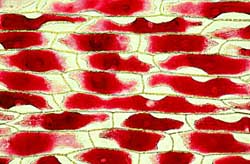DK Nature: Cells
The tiniest living unit that exists is a cell. Cells are the building blocks of all organisms. Each cell has a nucleus containing a set of building instructions called GENES.
Most organisms consist of many different types of cell, each with a specific role to play. Cells with a similar task, such as muscle cells in an animal, are organized into a group. This group, called a tissue, carries out a particular function, such as bending a leg.
Both plant and animal cells have a nucleus and a plasma membrane and contain cytoplasm. Plant cells, however, have a fluid-filled vacuole and green structures called chloroplasts. Chloroplasts make food using sunlight energy in a process called photosynthesis. Animal cells must absorb food to survive.
The features of living things are controlled by their genes. The genes inside an organism’s cells contain the instructions to make proteins, which build that cell and control the way it works. Genes are inherited by offspring from their parents.
Genes are made of a chemical substance called deoxyribonucleic acid (DNA). It is stored in the nucleus of all cells. DNA holds instructions for making the proteins needed for the growth and development of new organisms. It also passes on genetic information to the next generation.
Inside a cell’s nucleus, DNA is packaged into long, threadlike structures called chromosomes. They are visible only under a microscope when the cells divide. During cell division, chromosomes shorten and thicken, then split into identical halves, one for each new cell. Chromosome numbers vary between species.


